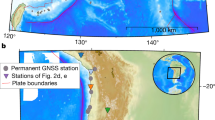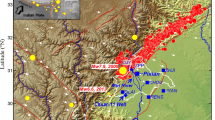Abstract
Using seismographs and GPS displacement measurements, we have estimated the seafloor deformation history of the December 2004 Sumatra-Andaman earthquake and the March 2005 Nias earthquake by separating their deformation period into intervals of 800-s, 1-h, and 6-months. We have then calculated their corresponding gravity changes (induced by the seafloor deformation), which are 11.3, 12.5, and 14.9 microgalileo, respectively. We show that the seismographs and GPS-derived values are consistent with the known postseismic to coseismic moment ratio of 30% and the Gravity Recovery and Climate Experiment (GRACE) satellites measurements of 15 microgalileo for the same period of 6 months. However, the vertical component of the accumulated seafloor deformation during the tsunami formation period (~30 min) could only generate a potential energy of 1.2 × 1015 Joules and account for only one third of the actual tsunami height. The evidence is overwhelmingly contrary to the long-held theory that the vertical deformation of seafloor is the primary source of tsunamis.
Furthermore, we have carefully examined the pioneering wave-maker experiment that initially conceived the ubiquitous tsunami genesis theory. Surprisingly, we found that the experimental ratio of the horizontal slip distance to the water depth – the non-dimensional parameter that allows comparing the experiment with reality on an apple-to-apple basis – was 200 times of realistic earthquake parameters. The experimental conclusion is problematic in conceiving the tsunami theory. By including the horizontal momentum energy transferred by the faulting continental slope in a three-dimensional tsunami model, we have re-examined the December 2004 tsunami using both seismographs and GPS measurements. Our results show that the new theory is more consistent with altimetry and tide data than the conventional theory of using the vertical force alone, suggesting that the tsunami formation mechanism is not as simple as previously thought.
Access this chapter
Tax calculation will be finalised at checkout
Purchases are for personal use only
Similar content being viewed by others

References
Abe K (1973) Tsunami and mechanism of great earthquakes. Phys Earth Planet Inter 7:143–153
Ammon CJ et al. (2005) Rupture process of the 2004 Sumatra-Andaman earthquake. Science 20:1133–1139
Blewitt G et al. (2006) Rapid determination of earthquake magnitude using GPS for tsunami warning systems. Geophys Res Lett 33:L11309. doi:10.1029/2006GL026145
Chen JL et al. (2007) GRACE detects coseismic and postseismic deformation from the Sumatra-Andaman earthquake. Geophys Res Lett 34:L13302. doi:10.1029/2007GL030356
Chlieh M et al. (2007) Coseismic slip and afterslip of the great Mw 9.15 Sumatra-Andaman earthquake of 2004. Bull Seismol Soc Am 97. doi:10.1785/0120050631
Choi BH, Hong SJ, Pelinovsky E (2006) Distribution of runup heights of the December 24, 2004 tsunami in the Indian Ocean. Geophys Res Lett 33:L13601. doi:10.1029/2006GL025867
Dutykh D, Dias F, Kervella Y (2006) Linear theory of wave generation by a moving bottom. C R Acad Sci Paris Ser I 343:499–504
Grilli T et al. (2007) Source constraints and model simulation of the December 26, 2004 Indian Ocean tsunami. J Waterway Port Coast Ocean Eng 133(6):414–428
Hammack JL (1973) A note on tsunamis: their generation and propagation in an ocean of uniform depth. J Fluid Mech 60(4):769–799
Han S-C et al. (2006) Crustal dilatation observed by GRACE after the 2004 Sumatra-Andaman earthquake. Science 313:658–662
Hirata K et al. (2006) The 2004 Indian Ocean tsunami: tsunami source model from satellite altimetry. Earth Planets Space 58:195–201
Hjorleifsdottir V (2007) Earthquake source characterization using 3D numerical modeling. PhD Thesis, Caltech. http://etd.caltech.edu/etd/available/etd-03212007-170259/
Hsu Y-J et al. (2006) Frictional afterslip following the 2005 Nias-Simeulue earthquake, Sumatra. Science 312:1921–1926
Imamura F, Shuto N, Ide S, Yoshida Y, Abe K (1993) Estimate of the tsunami source of the 1992 Nicaraguan earthquake from tsunami data. Geophys Res Lett 20(14):1515–1518
Iwasaki S (1982) Experimental study of a tsunami generated by a horizontal motion of a slo** bottom. Bull Earthq Res Inst Univ Tokyo 57:239–262
Ji C (2004) http://neic.usgs.gov/neis/eq_depot/2004/eq_041226/neic_slav_ff.html
Johnson JM (1999) Heterogeneous coupling along Alaska-Aleutians and interred from tsunami, seismic, and geodetic inversions. Adv Geophys 39:1–116
Moran K, Austin JA, Tappin DR (2005) Survey presents broad approach to tsunami studies. Trans EOS, AGU 86:430
Merrifield MA et al. (2005) Tide gauge observations of the Indian ocean tsunami, December 26, 2004. Geophy Res Lett 32:L09603. doi:10.1029/2005GL022610
Okada Y (1985) Surface deformation due to shear and tensile faults in a half-space. Bull Scismol Soc Am 75:1135–1154
Satake K (1994) Mechanism of the 1992 Nicargua tsunami earthquake. Geophys Res Lett 21:2519–2522
Satake K (1995) Linear and nonlinear computations of the 1992 Nicaragua earthquake tsunami. PAGEOPH 144:455–470
Song YT (2007) Detecting tsunami genesis and scales directly from coastal GPS stations. Geophy Res Lett 34. doi:10.1029/2007GL031681
Song YT et al. (2005) The 26 December 2004 tsunami source estimated from satellite radar altimetry and seismic waves. Geophys Res Lett 23. doi:10.1029/2005GL023683
Song YT et al. (2008) The role of horizontal impulses of the faulting continental slope in generating the 26 December 2004 tsunami. Ocean Modell. doi:10.1016/j.ocemod.2007.10.007
Tanioka Y, Satake K (1996) Tsunami generation by horizontal displacement of ocean bottom. Geophy Res Lett 23(8):861–864
Titov VV et al. (2005) The global reach of the 26 December 2004 Sumatra tsunami. Science 309:2045–2048
Tuck EO, L-S Hwang (1972) Long wave generation on a slo** beach. J Fluid Mech 51:449–461
Vennard JK, Street RL (1982) Elementary fluid mechanics, 6th edn. John Willey & Sons, New York, p 689
Vigny C et al. (2005) Insight into 2004 Sumatra-Andaman earthquake from GPS measurements in Southeast Asia. Nature 436:201–206
Acknowledgements
The research described here was conducted partially at the Jet Propulsion Laboratory, California Institute of Technology, under contracts with the National Aeronautics and Space Administration (NASA). We appreciate the valuable contributions from Prof. Hiroo Kanamori, who has participated in discussing the work, revising the manuscript, and providing helpful comments.
Author information
Authors and Affiliations
Corresponding author
Editor information
Editors and Affiliations
Rights and permissions
Copyright information
© 2011 Springer-Verlag Berlin Heidelberg
About this chapter
Cite this chapter
Song, Y.T., Han, SC. (2011). Satellite Observations Defying the Long-Held Tsunami Genesis Theory. In: Tang, D. (eds) Remote Sensing of the Changing Oceans. Springer, Berlin, Heidelberg. https://doi.org/10.1007/978-3-642-16541-2_17
Download citation
DOI: https://doi.org/10.1007/978-3-642-16541-2_17
Published:
Publisher Name: Springer, Berlin, Heidelberg
Print ISBN: 978-3-642-16540-5
Online ISBN: 978-3-642-16541-2
eBook Packages: Earth and Environmental ScienceEarth and Environmental Science (R0)



